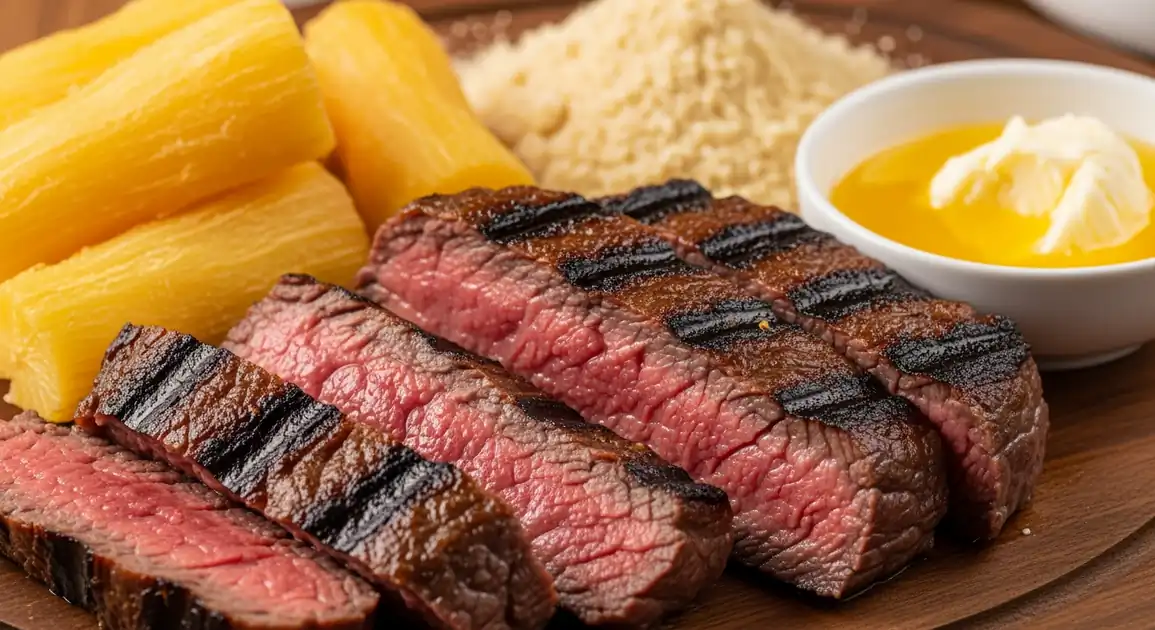Carne de Sol (Sun-Cured Beef)
Carne de Sol

Description
Carne de Sol originated in the Northeast (Nordeste) region of Brazil and remains most iconic there. However, its popularity has spread, and it can be found in dedicated Northeastern restaurants ('Restaurantes Nordestinos') and traditional Brazilian eateries across the country, especially in major cities with large populations of Northeastern migrants.
Dietary Information
Serving information
Serving style
Served hot, usually sliced or as steaks, often on a platter with generous portions of accompaniments like fried or boiled cassava ('aipim'/'macaxeira'), farofa, manteiga de garrafa, rice, beans, and sometimes vinaigrette. Often served family-style.
Quick facts
Restaurant hours, typically Lunch (12 PM - 4 PM) and Dinner (7 PM - 11 PM).
Safety Tips
What to Look For
-
Served piping hot
Ensures the meat is thoroughly cooked and safe to eat right after preparation.
-
Reputable Restaurant/Eatery
Choose places known for good quality Northeastern food or with positive hygiene ratings.
-
Meat looks properly cooked
Should have appropriate color for grilled/fried beef, indicating it's cooked through.
-
Fresh accompaniments
Sides like farofa, vinaigrette, and particularly the 'manteiga de garrafa' should look and smell fresh.
-
Clean dining environment
General cleanliness is a good indicator of overall hygiene standards.
What to avoid
-
Lukewarm or cold meat
Indicates improper holding temperature, posing a food safety risk.
-
Meat that appears undercooked
Beef should be cooked to a safe internal temperature.
-
Establishments with poor hygiene
Avoid places that seem unclean or have poor food handling practices.
-
Rancid 'manteiga de garrafa' or stale farofa
Accompaniments should be fresh; rancid butter can cause illness and stale farofa ruins the texture.
-
Overly dry or tough meat
While not necessarily unsafe, it indicates poor preparation or low-quality meat.
Price information
Price range
Budget tips
- Prices per portion can vary significantly based on restaurant location and level. Northeastern restaurants often offer better value.
- Portions are usually large and meant for sharing ('para dividir').
- Look for it as part of an 'executivo' (set lunch menu) for better deals.
Value indicators
- Tender and moist meat.
- Authentic accompaniments (aipim, farofa, manteiga de garrafa).
- Generous portion size.
- Served hot and freshly cooked.
- Flavorful, slightly salty taste.
Where to Find This Dish
Northeast Brazil (e.g., Pernambuco, Ceará, Bahia)
The heartland, where it's a staple in almost every local restaurant and home.
Cities like Recife, Fortaleza, Salvador
Lunch, Dinner
Major Cities with Nordestino Communities (São Paulo, Rio, Brasília)
Found in specialized Northeastern restaurants and cultural centers (like CTN in São Paulo, Feira de São Cristóvão in Rio).
Restaurantes Nordestinos, Cultural Fairs
Lunch, Dinner, Weekends
Vendor Tips
- Seek out 'Restaurantes Nordestinos' for the most authentic experience outside the Northeast.
- Portions are often very large; consider sharing if dining alone or in a small group.
- Don't skip the 'manteiga de garrafa' – it's a key part of the traditional flavor.
How to Order
Regional Variations
-
Carne de Sol na Brasa
(Carne de Sol na Brasa)
Grilled over charcoal, offering a smoky flavor.
-
Carne de Sol de Chapa / Frita
(Carne de Sol de Chapa / Frita)
Pan-fried or cooked on a flat-top griddle.
-
Carne de Sol Acebolada
(Carne de Sol Acebolada)
Served topped with sautéed onions.
-
Carne de Sol Cozida / na Nata
(Carne de Sol Cozida / na Nata)
Sometimes stewed until very tender, occasionally cooked in cream ('nata') in some regional recipes.
-
Different Cuts of Beef
(Cortes Diferentes de Carne)
While traditionally specific cuts are used, variations might employ different beef cuts.
-
'Serenada' Meat
(Carne Serenada)
A very similar preparation found in some regions, essentially another name for lightly cured air-dried meat.
Cultural context
History
The origins of Carne de Sol are deeply rooted in the 'sertão' (arid backcountry) of Northeastern Brazil, dating back to colonial times. It emerged as a vital method for preserving beef in a hot climate before refrigeration, allowing cattle ranchers ('vaqueiros') and sertanejos to conserve meat for longer periods. The technique involves light salting and utilizing the dry air and sun for dehydration. Carne de Sol became a staple food and cultural symbol of the Nordeste, eventually spreading in popularity throughout Brazil.
Local significance
A strong symbol of Northeastern Brazilian culture, resilience, and cuisine ('comida sertaneja'). Represents traditional food preservation techniques.
Eating customs
- Eaten as a substantial main course.
- Combining all elements (meat, cassava, farofa, butter) in one bite is typical.
- Sharing large platters is common.